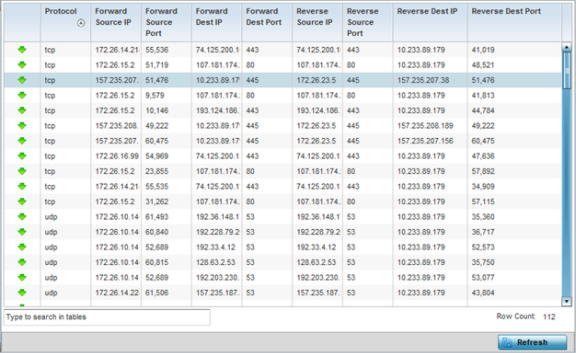NAT Translations
NAT (Network address translation ) is a technique to modify network address information within IP packet headers in transit. This enables mapping one IP address to another to protect wireless controller managed network address credentials. With typical deployments, NAT is used as an IP masquerading technique to hide private IP addresses behind a single, public facing, IP address.
NAT can provide a profile outbound Internet access to wired and wireless hosts connected to either an access point or a wireless controller. Many-to-one NAT is the most common NAT technique for outbound Internet access. Many-to-one NAT allows an access point or wireless controller to translate one or more internal private IP addresses to a single, public facing, IP address assigned to a 10/100/1000 Ethernet port or 3G card.
To assess a controller or service platform's NAT statistics:
- Select the Statistics menu from the Web UI.
- Expand the System node from the navigation pane (on the left-hand side of the screen). The System node expands to display the RF Domains created within the managed network.
- Expand the RF Domain node.
- Select a Wireless Controller.
- Expand the Firewall menu from the left-hand side of the UI.
- Select NAT
Translations.
The screen displays in the right-hand pane.
 This screen displays the following information:
This screen displays the following information:Protocol Displays the IP translation protocol as either TCP, UDP or ICMP.
Forward Source IP Displays the internal network IP address for forward facing NAT translations.
Forward Source Port Displays the internal network port for forward facing NAT translations.
Forward Dest IP Displays the external network destination IP address for forward facing NAT translations.
Forward Dest Port Displays the external network destination port for forward facing NAT translations.
Reverse Source IP Displays the internal network IP address for reverse facing NAT translations.
Reverse Source Port Displays the internal network port for reverse facing NAT translations.
Reverse Dest IP Displays the external network destination IP address for reverse facing NAT translations.
Reverse Dest Port Displays the external network destination port for reverse facing NAT translations.
- Select Refresh to update the screen's statistics counters to their latest values.



